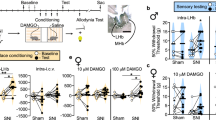Abstract
Amygdalar neurons respond to complex visual stimuli and activity changes at the sight of food (Ono et al., 1983; Sanghera et al., 1979). The amygdala (AM) is among the richest of the brain areas in opioid receptors and endogenous ligands, but the functional role of its opioid system in feeding behavior is not yet understood.
Access this chapter
Tax calculation will be finalised at checkout
Purchases are for personal use only
Preview
Unable to display preview. Download preview PDF.
Similar content being viewed by others
References
Aou, S., Oomura, Y., Nishino, H., Inokuchi, A., and Mizuno, Y., 1983, Influence of catecholamines on reward-related neuronal activity in monkey orbitofrontal cortex, Brain Res. 267: 165–170.
Aou, S., Oomura, Y., Lénârd, L., Nishino, H., Inokuchi, A., Minami, T. and Misaki, H., 1984, Behavioral significance of monkey hypothalamic glucose-sensitive neurons, Brain Res. 302: 69–74.
Beninger, R. J., 1983, The role of dopamine in locomotor activity and learning, Brain Res. Rev. 6: 173–196.
Ellis, M. E., 1984, Manipulation of the amygdala noradrenergic system impairs extinction of passive avoidance, Brain Res. 324: 129–133.
Gallagher, M., Kapp, B. S., Pascoe, J. P., and Rapp, P. R., 1981, A neuropharmacology of amygdala systems which contribute to learning and memory, in: The Amygdaloid Complex (Y. Ben-Ari, ed.), Elsevier, Amsterdam, pp. 343–354.
Goodman, R. R., Snyder, S. H., Kuhar, M. J., and Young, W. S., III, 1980, Differentiation of delta and mu opiate receptor localization by light microscopic autoradiography, Proc. Natl. Acad. Sci. U.S.A. 77: 62396243.
Halsband, V., and Passingham, R., 1982, The role of premotor and parietal cortex in the direction of action, Brain Res. 240: 368–372.
Heffner, T. G., Luttinger, D., Hartman, J. A., and Seiden, L. S., 1981, Regional changes in brain catecholamine turnover in the rat during performance of fixed ratio and variable interval schedules of reinforcement, Brain Res. 214: 215–218.
Kusama, T., and Mabuchi, M., 1970, Stereotoxic Atlas of the Brain of Macaca fuscata, University of Tokyo Press, Tokyo.
Leibowitz, S. F., 1980, Neurochemical systems of the hypothalamus: Control of feeding and drinking behavior and water—electrolyte excretion, in: Handbook of the Hypothalamus, Volume 3, Part A ( P. J. Morgane and J. Panksepp, eds.), Marcel Dekker, New York, pp. 299–437.
Lénârd, L., and Hahn, Z., 1982, Amygdalar noradrenergic and dopaminergic mechanisms in the regulation of hunger and thirst-motivated behavior, Brain Res. 233: 115–132.
Mason, S. T., and Fibiger, H. C., 1978, 6-OHDA lesion of the dorsal noradrenergic bundle alters extinction of passive avoidance, Brain Res. 152: 209–214.
Nakano, Y., Lénârd, L., Oomura, Y., Nishino, H., Aou, S., and Yamamoto, T., 1987, Functional involvement of catecholamines in reward related neuronal activity of the monkey amygdala, J. Neurophysiol. 57: 7291.
Nakano, Y., Oomura, Y., Lénârd, L., Nishino, H., Aou, S., Yamamoto, T., and Aoyagi, K., 1986, Feeding related activity of glucose and morphine sensitive neurons in the monkey amygdala, Brain Res. 399: 167172.
Ono, T., Fukuda, M., Nishino, H., Sasaki, K., and Muramoto, K., 1983, Amygdaloid neuronal responses to complex visual stimuli in an operant feeding situation in the monkey, Brain Res. Bull. 11: 515–518.
Oomura, Y., Nishino, H., Aou, S., and Lenard, L., 1986, Opiate mechanism in reward-related neuronal responses during operant feeding behavior of the monkey, Brain Res. 365: 335–339.
Sanghera, M. K., Rolls, E. T., and Roper-Hall, A., 1979, Visual responses of neurons in the dorsolateral amygdala of the alert monkey, Exp. Neurol. 63: 610–626.
Wise, R. A., and Schwartz, H. V., 1981, Pimozide attenuates acquisition of lever-pressing for food in rats, Pharmacol. Biochem. Behay. 15: 655–656.
Author information
Authors and Affiliations
Editor information
Editors and Affiliations
Rights and permissions
Copyright information
© 1988 Springer Science+Business Media New York
About this chapter
Cite this chapter
Oomura, Y., Nakano, Y., Lénárd, L., Nishino, H., Aou, S. (1988). Catecholaminergic and Opioid Mechanisms in Conditioned Food Intake Behavior of the Monkey Amygdala. In: Woody, C.D., Alkon, D.L., McGaugh, J.L. (eds) Cellular Mechanisms of Conditioning and Behavioral Plasticity. Springer, Boston, MA. https://doi.org/10.1007/978-1-4757-9610-0_12
Download citation
DOI: https://doi.org/10.1007/978-1-4757-9610-0_12
Publisher Name: Springer, Boston, MA
Print ISBN: 978-1-4757-9612-4
Online ISBN: 978-1-4757-9610-0
eBook Packages: Springer Book Archive




